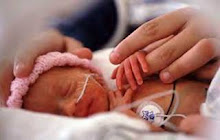Music, Pregnancy, Preemies, and Healing
 I found a really interesting blog today, which I’ll have to go back to and look over more thoroughly when I have the time! But just to kindle your interest (as it did mine!)…the focus of Pregnancy and Preemies blog is on “using music to heal and bond with your infant and to document the proven effects of music in these situations.”
I found a really interesting blog today, which I’ll have to go back to and look over more thoroughly when I have the time! But just to kindle your interest (as it did mine!)…the focus of Pregnancy and Preemies blog is on “using music to heal and bond with your infant and to document the proven effects of music in these situations.”
Singing lullabies to your baby is one of the most natural things a mother does. However, sometimes, people tend to underestimate the power of simple things. In this case, the research is there: singing to your baby, both before and after birth, creates a bond that is the foundation of healthy relationships… The research documents that lullabies:
-
Create a sonic bond of love and caring, even before birth
-
Ensure that baby comes into world knowing mother’s voice and associating that with being loved and cared for
With preemies, this is even more critical.
Amazingly, when Mom sings to baby the effect is:
-
Stabilized blood pressure
-
Stabilized body temperature
-
Stabilized pulse and heart rate
Resulting in:
-
Less time in NICU
-
Faster weight gain
-
Healthier baby at discharge from NICU
The blogger, Dr. Alice Cash, trained as a classical, concert pianist who stepped into the world of music as medicine in 1990. Now working as a clinical musicologist, she is the mother of three daughters, all of whom heard these lullabies before and after birth. All three are now professional musicians or artists!
Your teeth need extra attention during pregnancy!
There’s a saying that goes, “Have a baby, lose a tooth.”
Dr. Dana Keiles, who practices dentistry in Yorktown Heights, N.Y, calls it an old wives tale. “But there are a lot of hormonal things going on during pregnancy that can cause serious problems, so it’s important to practice good oral hygiene.”
On top of that, about 50 percent of women experience pregnancy gingivitis, a gum disease caused by elevated hormone levels, according to the American Academy of Periodontology. The hormones react with plaque at the gum line, causing inflammation. Studies show that women with gum disease are more likely to give birth prematurely or bear full-term babies with low birth weights, which puts the infants at risk of developing serious health problems such as cerebral palsy, blindness and deafness. In addition, a study published in the April 2008 issue of the Journal of Dental Research suggests that women with gum disease are more likely to develop gestational diabetes.
The transfer of bacteria from a mother’s mouth to her unborn child and the rest of her body is probably to blame for these systemic health problems; however, other factors such as stress may come into play as well, says Dr. Jennifer Holtzman, assistant professor of clinical dentistry, University of Southern California, Los Angeles.
In the general population, gum disease has been linked to heart disease and stroke.
“The best way to prevent and control gum disease is to make sure you clean the plaque off your teeth,” Holtzman says, adding that there are over-the-counter “disclosing agents” people can buy to dye and reveal any bacteria they missed while brushing and flossing.
Keiles recommends that women undergo a thorough dental exam if they are planning to get pregnant and that they have their teeth professionally cleaned every three months once they’re expecting.
She also recommends that pregnant women who suffer morning sickness or nausea rinse their mouths out if they vomit because stomach acid can damage tooth enamel.
Source: NY Daily News
Dancing through your pregnancy
 I came across a dance blog with reference to pregnancy. I’m sure some dancers out there are wondering how becoming pregnant will affect their ability to perform, so I will post the following entry from Teaching Smart. I hope it is helpful!
I came across a dance blog with reference to pregnancy. I’m sure some dancers out there are wondering how becoming pregnant will affect their ability to perform, so I will post the following entry from Teaching Smart. I hope it is helpful!
I am just into my pregnancy and work as a contemporary dancer and physical theatre performer. I hope not to stop my work and performances until my 7th or 8th month. However I know that I will have to modify my work and I’m game for that. I can’t seem to find a good resource — a book, a detailed article, anything! — that explains what activity should be modified and how to modify the activity as time goes on. Most of what I’ve found is very general or specific to elite athletes like runners. Do you have any recommendations?
Sincerely,
Lucy
I don’t know of any specific resources to send you to, Lucy, so I will give you my personal opinion after having 3 of my own – and counseling a few friends through their pregnancy and births.
The first is – your iliopsoas is going to take a beating with being pregnant. As the baby gets bigger, the pull on your lower back is significant. The one stretch you  cannot stop doing is some form of iliopsoas stretching. (I actually have a youtube video on 3 different ways to stretch your psoas) The one stretch that I don’t have on this video is a sitting stretch – but here it is on the right.
cannot stop doing is some form of iliopsoas stretching. (I actually have a youtube video on 3 different ways to stretch your psoas) The one stretch that I don’t have on this video is a sitting stretch – but here it is on the right.
Ballwork all around the pelvis will be very useful for keeping the muscles looser. As your belly pulls the pelvis into a forward tilt, the abdominals contract to counter that and the gluteals also tend to contract more than normal to keep your pelvis upright.
Continuing dancing will help keep the abdominals in good shape – and stretching and ballwork will definitely help the gluts!
Those are my primary tips for a healthy pregnancy. It goes without saying that listening to your body is key – and – it is an amazing process that you are engaged with. Typically, the pregnant dancers I’ve known have, for the most part, had easier pregnancies than non-dancers. They danced as long as they were comfortable – and easily modified their movement. (for example, rolling down the spine becomes almost impossible – so do hamstring stretches standing with your leg on a chair instead) I truly enjoyed all 3 of my pregnancies. Best wishes and…
Congratulations!
Deborah
How to Create a Digital Pregnancy Memory Album
 A baby memory album will help you collect and save memories of your pregnancy – the moment you found out you were pregnant, the first time you heard your baby’s heartbeat, that mysterious ultrasound photo. You’ll be able to cherish it forever and share it with your child. The best part about making a digital book is that you don’t have to be artistic. Anyone can create a beautiful baby memory book these days! Choose your preferred book-making application; below are some options to look into:
A baby memory album will help you collect and save memories of your pregnancy – the moment you found out you were pregnant, the first time you heard your baby’s heartbeat, that mysterious ultrasound photo. You’ll be able to cherish it forever and share it with your child. The best part about making a digital book is that you don’t have to be artistic. Anyone can create a beautiful baby memory book these days! Choose your preferred book-making application; below are some options to look into:
Free Systems that allow large quantities of text and many pages
-
iMemoryBook Baby Memory Books – Online bookmaking that lets your collaborate with family and friends to create your baby memory book.
-
SharedBook Collaborative online memory book system.
Photo Books – (photos with captions)
-
PhotoWorks – Online Photo Book application.
-
SnapJot Online Collaborative Photo book making application.
-
MyPublisher Download photo book software.
-
Shutterfly Create Photo Gifts online
Professional Software ($600+)
-
Adobe inDesign Page layout and design software for creative professionals
-
Quark Makers of design, page layout, publishing, enterprise workflow, personalization, and content management software.
Now it’s time to get started! Here are some tips on how to go about it:
- Keep a camera and film on hand at all times.
- Put together your baby memory book as the pregnancy progresses, or assemble your different stories in a notebook and make it all at once.
- Collect memorabilia. Include things like photos of mom taken every two weeks (stand next to the same object for comparison). Save tags from maternity clothes and pressed flowers from the night baby was conceived and scan them into your book.
- Don’t forget to include an account of how mom told dad she was pregnant, a photo of parents assembling the crib, and photos of when you were decorating the nursery.
- Document food cravings. Tell funny stories about midnight runs for those cravings.
- Document expanding sizes, new developments and changing name choices.
- Make a family tree.
- Tape interviews with family members for ideas about what will change, what the baby will be like and what their hopes are for the future. If you are using a collaborative memory book system (e.g. iMemoryBook, Snapjot), invite them by email to come and add their insights (If your system of choice doesn’t have collaboration, just have them each write on a page).
- Be sure that both mom and dad write a special section full of their individual hopes and dreams for the new baby.
- Don’t forget to include space for sonogram photos, hospital photos and items, and birth pictures.
Pregnant women: Increase fiber, Decrease risk of preeclampsia
 Fiber… it doesn’t just help you out in the bathroom department. Consuming enough fiber can also help pregnant women to have a healthy pregnancy, according to WKRG.com.
Fiber… it doesn’t just help you out in the bathroom department. Consuming enough fiber can also help pregnant women to have a healthy pregnancy, according to WKRG.com.
Between three and seven percent of all pregnant women can face a dangerous condition called preeclampsia. “It consists of high blood pressure developing and then often the baby will be affected, be growth restricted and then the mother actually can get very ill from the disease and need early delivery,” said Maternal Fetal Medicine Dr. Tanya Sorensen.
Researchers took a look at 1,500 women and found that women who had normal recommended amounts of fiber – -around 20 to 30 grams per day — had lower risks of preeclampsia by 70% compared to women with lower fiber intake.
Good sources of fiber include whole fruits and vegetables, whole grain breads and breakfast cereals, and all manner of beans.
Some tips for increasing fiber intake, from the Harvard School of Public Health:
-
Eat whole fruits instead of drinking fruit juices.
-
Replace white rice, bread, and pasta with brown rice and whole grain products.
-
Choose whole grain cereals for breakfast.
-
Snack on raw vegetables instead of chips, crackers, or chocolate bars.
-
Substitute legumes for meat two to three times per week in chili and soups.
-
Experiment with international dishes (such as Indian or Middle Eastern) that use whole grains and legumes as part of the main meal (as in Indian dahls) or in salads (for example, tabbouleh).
Have a happy, healthy, and safe Thanksgiving with tips from Dr. Sears
Ten Tips for a Healthy Thanksgiving Feast!
 You know how much I love Dr. Sears, and once again he’s sharing some great ideas to make the holidays not just fun and delicious, but safe and nutritious too!
You know how much I love Dr. Sears, and once again he’s sharing some great ideas to make the holidays not just fun and delicious, but safe and nutritious too!
Here’s a reminder list of a few healthy ideas to make your Thanksgiving day just a bit healthier. Of course, it IS Thanksgiving and a little overindulgence is OK. Happy Thanksgiving!!!
1. Use whole wheat or whole grain bread for your stuffing instead of white bread.
2. Make homemade cranberries instead of the jellied cranberries in a can. See our recipe: http://www.askdrsears.com/news/thanksgiving.asp#1
3. Buy an all natural hormone-free Turkey for the main event.
4. Substitute Omega-3 enriched oil-based spread instead of butter, margarine or shortening.
5. Offer more healthy vegetable dishes to balance out all the starches like stuffing and potatoes.
6. Bake your dishes instead of frying when possible.
7. Keep the skin on. Encourage eating the skin of your sweet potatoes and leave the skin on your mashed potatoes. Potato skin is loaded with vitamins.
8. Use whole wheat pie-crust on one or more of your pies for a healthier alternative.
9. Use fresh all-natural ingredients whenever possible, they are always healthier than something out of a can or a box.
10. Watch the salt! Most recipes already contain enough salt and don’t need more once they are on your plate.
We hope this inspires you to try a healthier (yet still delicious) version of Thanksgiving dinner. While you are preparing your dinner, you will probably come up with some of your own healthy ideas. Once again, Happy Thanksgiving!!
Click here for more healthy Thanksgiving tips and recipes.
Keeping Your Family Safe in the Kitchen on Thanksgiving
 According to the National Fire Protection Association, fires are more likely to occur on Thanksgiving Day than any other day of the year. Kitchen fires from cooking are the number one cause of home fires and home fire injuries. In fact, the number of structure fires that occur on Thanksgiving Day is three times higher than the daily average of structure fires in the US.
According to the National Fire Protection Association, fires are more likely to occur on Thanksgiving Day than any other day of the year. Kitchen fires from cooking are the number one cause of home fires and home fire injuries. In fact, the number of structure fires that occur on Thanksgiving Day is three times higher than the daily average of structure fires in the US.
Here are a few tips to prevent home fires this Thanksgiving:
-
Keep your stove clear. 12% of all fires occur because something that could catch fire was too close to the stove; dish towels, pot holders, food packaging and even wooden utensils.
-
Stay in the kitchen. Don’t leave your stove unattended while cooking, if you have to step away, even for a short time, turn off the stove. Unattended cooking is the leading cause of Thanksgiving Day home fires.
-
Set a timer. Aside from the obvious, not burning the turkey or pies, etc, this helps to keep track of food that requires extended cooking times as well as keeping your ears from hearing the piercing sound of the smoke alarm or worse.
-
Keep children out of the kitchen. Be sure to keep all pot handles turned in so they are not accessible to little hands. Cook on the back burner as much as possible.
-
Wear short or close fitting sleeves when cooking.
Even with the best preparation accidents can happen.
Click here to read Dr. Sears’ guide to treating burns; what to do immediately following a burn, how to treat the burn and whether or not you should page your doctor or take your child to the ER.
Online Support for Mom’s with High-Risk Pregnancy
lovemykids72704 is the group owner of Moms Who Have or Had a High-Risk Pregnancy at CafeMom. She shares some very personal, moving details about her 2 “high risk” pregnancies and why she decided to start the group. All moms-to-be share a common hope that their baby will be born healthy. Having a pregnancy that’s been deemed “high risk” adds some worry and uncertainty to things (although many, many women go on to deliver babies that are just fine), which is why it’s so wonderful to get support and encouragement from other pregnant moms in a similar situation. You can connect with them in High-Risk Pregnancies and Moms Who Have or Had a High-Risk Pregnancy.
Tell me a little about why you started the group.
I started this group because I had two high-risk pregnancies and was very lonely and could have used the support of other women who were going through similar experiences.
Are you pregnant now?
I’m not currently pregnant but would like to try for number three when the time is right. Both of my pregnancies were high-risk. With my first, I got an intrauterine infection that exposed the placenta and the baby — I went into preterm labor at 25 weeks and the baby girl (her name was Heather) was stillborn. We don’t know how I got the infection and why I didn’t show any signs of an infection until it was too late.
With my son it was different. I had preeclampsia and was on bed rest for five months of my pregnancy due to contractions, but everything turned out fine in the end despite the bumps in the road.
What would you say are the most common reasons moms in the group are considered high-risk?
Most women are considered high-risk if they’ve had a high-risk pregnancy previously — and there are many reasons a pregnancy can become high-risk, including a blood clotting disorder, incompetent cervix, diabetes, and preeclampsia.
What are the most common concerns of the moms in the group?
The main concern is to have a healthy baby, of course! However, a lot of them just want to be understood and to find the reasons and causes for their situation. They also want advice from other mothers — companionship and support, which is what the group gives.
Do moms typically report back after the birth to let others know how things turned out?
Some mothers do report back — you can make life-long friends in this group and we love to know how everything went.
Anything else you’d like moms to know?
I guess I’d like other moms to know that you are not alone. There is someone in this group that has — or had — the same issues that you might have. It helps to talk about them. I felt considerable loneliness when going through my pregnancies and would have loved to have had this group then. Pregnancy is not always an easy thing!
Does pregnancy make you feel Radiant?
Source: CartoonStock
11 COMMON SKIN CHANGES DURING PREGNANCY
The pregnancy glow might make you feel pretty, but there are other changes that may be unwelcome. I thought it might be good for you to know that all those weird skin conditions are actually normal, and will most likely disappear after the baby is born! Phew!! The following article, 11 COMMON SKIN CHANGES DURING PREGNANCY, comes straight off of Dr. Sear’s website. 
1. The “pregnancy glow.” The glow that others notice (though you may not) isn’t just a sentimental old wives’ term. This facial shine actually has a biological basis. The increased volume of blood causes the cheeks to take on an attractive blush, because of the many blood vessels just below the skin’s surface. On top of this redness, the increased secretions of the oil glands give the skin a waxy sheen. The flushed face on many pregnant women is similar to the one non-pregnant people experience when they are excited, cry, or do anything that increases their heart rate (which pregnancy does constantly). photo from EarthsBeauty.com
2. The pregnancy mask. Sometime during the second trimester you may find yourself gazing at a different face in the mirror. Brownish or yellowish patches called chloasma (also dubbed the mask of pregnancy) can appear anywhere on the face, but are seen most commonly on the forehead, upper cheeks, nose, and chin. The pregnancy hormones estrogen and progesterone stimulate the melanin cells in the skin to produce more pigment, yet because these cells do not produce extra pigment uniformly, your facial skin may acquire a blotchy tan. (If you have ever taken oral contraceptives, you may already have experienced this particular hormonal side-effect.) Brunettes and darker-skinned women may notice darkened circles, resembling eye shadow, around their eyes. Chloasma cannot be prevented, but you can minimize the intensity of these blotchy, darkened areas by limiting your exposure to ultraviolet light (i.e., sunshine), which further stimulates melanin production.
3. Acne. You probably thought your pimple days were over. While the acne of pregnancy is rarely as severe as that of adolescence, you may need to return to some of your teenage cleansing rituals. Fortunately, pregnancy is much shorter than adolescence; the bumps and pimples will subside shortly after delivery. Avoid abrasive scrubs or exfoliants; pregnant skin is too sensitive for these. Milder, oatmeal-based facial scrubs (available at nutrition stores) can help unplug the oily pores, and are much kinder to sensitive skin. Because of the risk of birth defects, the anti-acne prescription drugs Accutane and Retin-A cannot be used during pregnancy.
4. Linea nigra. >Many women normally have a faint linea alba (white line) running from their navel to the center of their pubic bone. It is barely visible before pregnancy. (You may not have even known it was there). Sometime in the second trimester a linea alba becomes a linea nigra, a dark line that is much more noticeable. In some women the line extends upward from the navel as well. The linea nigra is darker in darker skinned women and disappears several months after delivery.

5. Dark areas become darker. Little moles and freckles that existed prior to pregnancy may now become bigger, and brown spots or birthmarks become browner. New moles may also appear. (Consult your doctor or dermatologist if these moles seem particularly raised, dark, or have irregular borders.) The areola and nipples of your breasts will become quite a lot darker; unlike other areas of your skin, which return to their original color after pregnancy, your areola will probably always be somewhat darker than they were before you were pregnant.
6. Red palms and soles. Even as early as the second month of pregnancy, the insides of your hands and the bottoms of your feet may itch and take on a reddish hue, called palmar erythema. The increased color is nothing more than a curiosity of pregnancy.
7. Spider veins. Those much-discussed pregnancy hormones, along with increased blood volume, cause those tiny, squiggly red or purple capillaries just below the surface of the skin to branch out and become more visible during pregnancy. It’s also common for spider veins (they resemble a small spider web), to pop out on the face or on the sclera (white part) of the eyeballs during delivery; intense, red-in-the-face pushing can break tiny blood vessels. Known as nevi, these burst vessels can be camouflaged by the appropriate use of make- up. Nevi take longer to disappear than many of the other skin problems of pregnancy, some spider veins on the legs or torso may not go away on their own. A dermatologist can remove them using injections if you feel that’s necessary.
8. Skin tags. Some pregnant women develop tiny polyps, called skin tags, in areas where skin rubs on clothing or skin rubs together. Commonly found under the arms, between neck folds, or under bra lines on the chest, skin tags are caused by hyperactive growth of a superficial layer of skin. They disappear a few months following delivery, but can be easily excised if they bother you.
9. Heat rash. You may think that only babies get prickly heat rash, but pregnant women do, too. Caused by the combination of an already overheated pregnant body, dampness from excessive perspiration, and the friction of skin rubbing against itself or against clothing, prickly heat rash is pimply and slightly irritating. It is most common in the crease between and beneath the breasts, in the crease where the bulge of the lower abdomen rubs against the top of the pubic area, and on the inner thighs.
10. Itching. Many women enjoy a good “scratch down” at the end of the day. Some areas of your skin may itch because they are dry and flaky, others may itch because of a prickly rash, as mentioned above. Many women find the itching is most bothersome in the skin that stretches, mainly over the abdomen, but also on hips and thighs.
11. Pimply eruptions. Around one percent of pregnant women experience itchy, red, raised patches on their abdomen, thighs, buttocks, and extremities. This condition is called pruritic urticarial papules and plaques of pregnancy (dubbed PUPP). It tends to come and go during the second half of pregnancy and nearly always disappears shortly after delivery. Treat this the same as any other itchy skin eruption.










